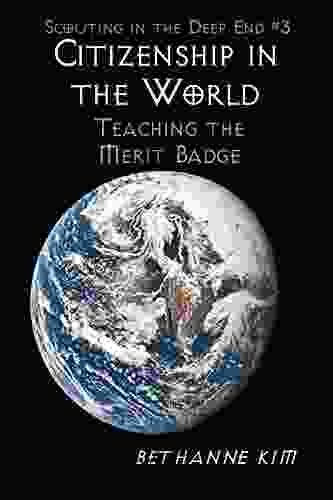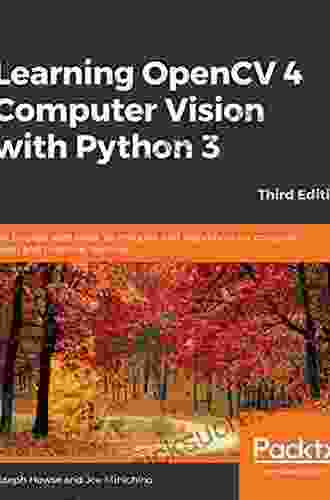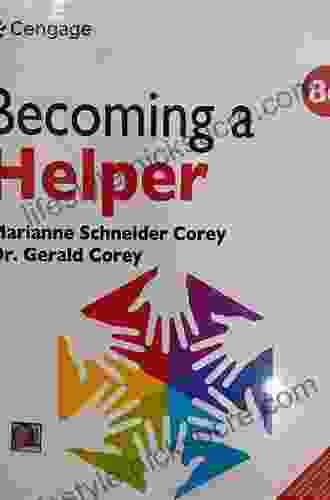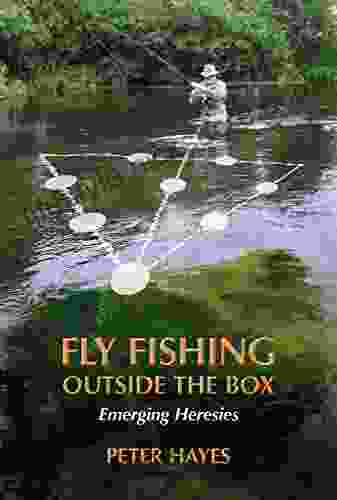Learning OpenCV Computer Vision With Python: A Comprehensive Guide

Welcome to the fascinating world of computer vision, where machines gain the ability to "see" and interpret images and videos. With OpenCV (Open Source Computer Vision Library) and the power of Python, you can unlock a myriad of possibilities in this exciting field.
4.3 out of 5
| Language | : | English |
| File size | : | 41148 KB |
| Text-to-Speech | : | Enabled |
| Screen Reader | : | Supported |
| Enhanced typesetting | : | Enabled |
| Print length | : | 374 pages |
In this comprehensive guide, we will dive deep into OpenCV and Python, providing you with the essential knowledge and practical skills to master computer vision. We will explore image processing, video processing, object detection, facial recognition, and more, empowering you to tackle real-world problems and create innovative applications.
Getting Started with OpenCV and Python
Before embarking on our computer vision journey, let's ensure you have the necessary tools at your disposal. Here's a step-by-step guide to get you up and running:
- Install Python: Visit the official Python website to download and install the latest version of Python.
- Install OpenCV: Open a terminal or command prompt and type the following command:
pip install opencv-python - Create a Python script: Create a new file with a
.pyextension (e.g.,opencv_intro.py) and open it with your preferred text editor.
Basic Image Processing with OpenCV
Let's start by exploring the fundamentals of image processing with OpenCV. We will cover essential operations such as image reading, displaying, converting, and basic image manipulation.
import cv2 # Read an image image = cv2.imread("image.jpg") # Display the image cv2.imshow("Original Image", image) cv2.waitKey(0) # Convert the image to grayscale gray_image = cv2.cvtColor(image, cv2.COLOR_BGR2GRAY) # Save the grayscale image cv2.imwrite("grayscale_image.jpg", gray_image)Advanced Image Processing Techniques
Now that you have a grasp of the basics, let's delve into more advanced image processing techniques. We will explore filtering, edge detection, image segmentation, and more.
import cv2 # Read an image image = cv2.imread("image.jpg") # Apply a Gaussian blur filter blurred_image = cv2.GaussianBlur(image, (5, 5),0) # Detect edges using the Canny edge detector edges = cv2.Canny(blurred_image, 100, 200) # Perform image segmentation using the watershed algorithm segmented_image = cv2.watershed(image, markers=cv2.connectedComponents(image)[1])Video Processing with OpenCV
OpenCV also empowers you to process videos. We will learn how to read, write, and manipulate videos, including frame extraction, background subtraction, and motion detection.
import cv2 # Open a video file video = cv2.VideoCapture("video.mp4") # Read the first frame ret, frame = video.read() # Display the first frame cv2.imshow("First Frame", frame) cv2.waitKey(0) # Extract all frames and save them as images while ret: ret, frame = video.read() if not ret: break cv2.imwrite("frame" + str(frame_count) + ".jpg", frame) frame_count += 1Object Detection with OpenCV
One of the most exciting applications of computer vision is object detection. We will explore how to detect objects in images and videos using OpenCV and pre-trained models.
import cv2 # Load a pre-trained object detection model model = cv2.dnn.readNetFromCaffe("deploy.prototxt.txt", "mobilenet_iter_73000.caffemodel") # Read an image image = cv2.imread("image.jpg") # Prepare the image for detection blob = cv2.dnn.blobFromImage(image, 0.007843, (300, 300)) # Set the input to the model model.setInput(blob) # Run the model and get the detections detections = model.forward() # Process the detections for detection in detections[0, 0]: if detection[2] > 0.5: x1, y1, x2, y2 = detection[3:7] * np.array([image.shape[1], image.shape[0], image.shape[1], image.shape[0]]) cv2.rectangle(image, (x1, y1),(x2, y2),(0, 255, 0),2)Facial Recognition with OpenCV
OpenCV also enables you to tackle facial recognition tasks. We will learn how to detect faces, identify facial landmarks, and recognize individuals using face embeddings.
import cv2 import face_recognition # Load the image image = cv2.imread("image.jpg") # Convert the image to RGB rgb_image = image[:, :, ::-1] # Detect faces face_locations = face_recognition.face_locations(rgb_image) # Recognize faces face_encodings = face_recognition.face_encodings(rgb_image, face_locations) # Compare unknown faces to known faces for face_encoding in face_encodings: match = face_recognition.compare_faces([known_face_encoding], face_encoding, tolerance=0.5) if match[0]: print("Matching face found!")Congratulations on completing this comprehensive guide to learning OpenCV computer vision with Python! We covered a wide range of topics, from basic image processing to advanced techniques like object detection and facial recognition.
Now, it's time for you to explore the exciting world of computer vision and create your own innovative applications. Remember, practice makes perfect, so keep experimenting with OpenCV and Python, and you will be amazed at the possibilities you can unlock.
Thank you for reading, and happy coding!
4.3 out of 5
| Language | : | English |
| File size | : | 41148 KB |
| Text-to-Speech | : | Enabled |
| Screen Reader | : | Supported |
| Enhanced typesetting | : | Enabled |
| Print length | : | 374 pages |
Do you want to contribute by writing guest posts on this blog?
Please contact us and send us a resume of previous articles that you have written.
 Fiction
Fiction Non Fiction
Non Fiction Romance
Romance Mystery
Mystery Thriller
Thriller SciFi
SciFi Fantasy
Fantasy Horror
Horror Biography
Biography Selfhelp
Selfhelp Business
Business History
History Classics
Classics Poetry
Poetry Childrens
Childrens Young Adult
Young Adult Educational
Educational Cooking
Cooking Travel
Travel Lifestyle
Lifestyle Spirituality
Spirituality Health
Health Fitness
Fitness Technology
Technology Science
Science Arts
Arts Crafts
Crafts DIY
DIY Gardening
Gardening Petcare
Petcare Nicholeen Peck
Nicholeen Peck Amber Foster
Amber Foster Julie Caplin
Julie Caplin Ned Vizzini
Ned Vizzini Joseph Wayne Smith
Joseph Wayne Smith Rick Deutsch
Rick Deutsch Dan Abnett
Dan Abnett Tim Hornbaker
Tim Hornbaker Jack Weatherford
Jack Weatherford Helen E Fisher
Helen E Fisher Adam Cort
Adam Cort Michelle Newhart
Michelle Newhart Tijan
Tijan Suzanne Stabile
Suzanne Stabile Temple Grandin
Temple Grandin Rob Antoun
Rob Antoun Jayson Gaddis
Jayson Gaddis Cordelia K Castel
Cordelia K Castel Don Stradley
Don Stradley Stephenie Meyer
Stephenie Meyer Nathan Belofsky
Nathan Belofsky Nikhil Bhardwaj
Nikhil Bhardwaj John A Buehrens
John A Buehrens Frederick Lenz
Frederick Lenz Alan Margot
Alan Margot Sarah Sumbal
Sarah Sumbal James W Williams
James W Williams Dan Schlossberg
Dan Schlossberg Robert Melillo
Robert Melillo Ned Seaton
Ned Seaton Jeremy J Baumberg
Jeremy J Baumberg Marshall Goldsmith
Marshall Goldsmith Jake Maddox
Jake Maddox Mac Fortner
Mac Fortner Lisa Zimmer Hatch
Lisa Zimmer Hatch Brian Pace
Brian Pace Christine Fanthome
Christine Fanthome Test Masters
Test Masters Brendan Leonard
Brendan Leonard Michael R Poll
Michael R Poll Philippa Langley
Philippa Langley Jessica Hatcher Moore
Jessica Hatcher Moore David Guymer
David Guymer Rick Stanton
Rick Stanton Stephen Barr
Stephen Barr John Lukacs
John Lukacs Steven Charleston
Steven Charleston Patrick O Sullivan
Patrick O Sullivan Vivian Vande Velde
Vivian Vande Velde Bill Carter
Bill Carter Gary Wiener
Gary Wiener Amelia Freer
Amelia Freer Laurie A Watkins
Laurie A Watkins Jean Rose
Jean Rose James Mullaney
James Mullaney Buck Tilton
Buck Tilton Charles Thompson
Charles Thompson Michael Reichert
Michael Reichert Dave Hanson
Dave Hanson Kyle Hunt
Kyle Hunt Tom Colicchio
Tom Colicchio Kate Fox
Kate Fox Steven C Hayes
Steven C Hayes Mark Turley
Mark Turley Nisha Garg
Nisha Garg Lady Antiva
Lady Antiva Trent Shelton
Trent Shelton Alex Polyakov
Alex Polyakov Jameson M Wetmore
Jameson M Wetmore Tracy Lorraine
Tracy Lorraine Kate Tietje
Kate Tietje Jenny Landreth
Jenny Landreth Mark Taylor
Mark Taylor Shanna Cunning
Shanna Cunning Chris Irons
Chris Irons Ruth M Tappen
Ruth M Tappen Erik Qualman
Erik Qualman Stephen Walker
Stephen Walker Jeffrey Steadman
Jeffrey Steadman Amie Lands
Amie Lands Deborah Lipsky
Deborah Lipsky Jack Freeman
Jack Freeman Zeshan Qureshi
Zeshan Qureshi Paul Oliver
Paul Oliver Brittany Clair
Brittany Clair Amy Camp
Amy Camp Tyler Simmons
Tyler Simmons Josephine Atluri
Josephine Atluri Reinhold Messner
Reinhold Messner Antonio R Damasio
Antonio R Damasio Marit Weisenberg
Marit Weisenberg Theresa Y Wee M D
Theresa Y Wee M D Stanley I Greenspan
Stanley I Greenspan Kathy Spratt
Kathy Spratt K M Shea
K M Shea David Salsburg
David Salsburg E T Bryant
E T Bryant Tamora Pierce
Tamora Pierce Terry Wieland
Terry Wieland Norman Doidge
Norman Doidge Swede Burns
Swede Burns Randall E Schumacker
Randall E Schumacker Chad Ford
Chad Ford Amber Lee Sellers
Amber Lee Sellers Charles J Alsheimer
Charles J Alsheimer Jonathan Law
Jonathan Law Jason Thompson
Jason Thompson Ken Chaddock
Ken Chaddock Patricia L Papernow
Patricia L Papernow Mark Stallard
Mark Stallard Benjamin Jelen
Benjamin Jelen Kevin Stiegelmaier
Kevin Stiegelmaier Chloe Gong
Chloe Gong Gia Giasullo
Gia Giasullo Thomas J Whalen
Thomas J Whalen Nick Kolenda
Nick Kolenda Isabella Krystynek
Isabella Krystynek Joseph Howse
Joseph Howse Victor J Stenger
Victor J Stenger Nina Freudenberger
Nina Freudenberger John Jacobs
John Jacobs Christopher Cousteau
Christopher Cousteau Deborah Vinall Psyd Lmft
Deborah Vinall Psyd Lmft Iain Pardoe
Iain Pardoe Paul Kockelman
Paul Kockelman William Rosen
William Rosen K F Breene
K F Breene Gail Maccoll
Gail Maccoll Eugenia Viti
Eugenia Viti Donna Williams
Donna Williams Sarah Woodbury
Sarah Woodbury Md Rezowan Ahmed
Md Rezowan Ahmed Howard J Meditz
Howard J Meditz Ruta Nonacs
Ruta Nonacs Louise Bates Ames
Louise Bates Ames Amber Lia
Amber Lia Michael Cosgrove
Michael Cosgrove Carlo Buzzichelli
Carlo Buzzichelli Amelia Edith Huddleston Barr
Amelia Edith Huddleston Barr Helena P Blavasky
Helena P Blavasky Amy Adele Hasinoff
Amy Adele Hasinoff Eugene C Toy
Eugene C Toy Tim Marshall
Tim Marshall Laini Taylor
Laini Taylor Summer Michaud Skog
Summer Michaud Skog J Stephen Jones
J Stephen Jones Joseph Conrad
Joseph Conrad Victoria Richards
Victoria Richards Bethanne Kim
Bethanne Kim Muhammad Vandestra
Muhammad Vandestra Amira Mikhail
Amira Mikhail Sharon K Zumbrunn
Sharon K Zumbrunn David Elkington
David Elkington Mariano Anaya
Mariano Anaya John L Field
John L Field C W Lockhart
C W Lockhart Peter Larson
Peter Larson Matthew Lombardi
Matthew Lombardi Rose Mannering
Rose Mannering Tahlia Kirk
Tahlia Kirk Fred Pyrczak
Fred Pyrczak Richard Wagamese
Richard Wagamese Deborah J Rumsey
Deborah J Rumsey Cookie O Gorman
Cookie O Gorman Therese A Rando
Therese A Rando Eric Zweig
Eric Zweig Anna B Doe
Anna B Doe Robyn Davidson
Robyn Davidson Dr Scott A Johnson
Dr Scott A Johnson Guillaume Haeringer
Guillaume Haeringer Umer W
Umer W Kathleen Glasgow
Kathleen Glasgow Ananda Lowe
Ananda Lowe William Glasser M D
William Glasser M D Pinky Mckay
Pinky Mckay Theodore Sider
Theodore Sider Ruth Nestvold
Ruth Nestvold Thom Hartmann
Thom Hartmann Tavi Gevinson
Tavi Gevinson Jeanne Ryan
Jeanne Ryan Amy Perry
Amy Perry Laura Slinn
Laura Slinn Joseph P Weir
Joseph P Weir Elise Christie
Elise Christie Rosalind Wiseman
Rosalind Wiseman Leslie Sansone
Leslie Sansone Brian Klaas
Brian Klaas Shere Hite
Shere Hite Amara Charles
Amara Charles Joan Freeman
Joan Freeman Mark Worden
Mark Worden Martin Pollizotto
Martin Pollizotto Christopher E Larsen
Christopher E Larsen Garrett M Fitzmaurice
Garrett M Fitzmaurice Amante P Marinas
Amante P Marinas Amir Alexander
Amir Alexander Jan Marie Mueller
Jan Marie Mueller John Mcpherson
John Mcpherson Paul Kaplowitz
Paul Kaplowitz Joseph Mcmoneagle
Joseph Mcmoneagle Heidi J Larson
Heidi J Larson Holly Herrick
Holly Herrick Sonia Hartl
Sonia Hartl Mark W T Harvey
Mark W T Harvey Catherine Dees
Catherine Dees Robert A Weinberg
Robert A Weinberg Gal Dem
Gal Dem Art Star
Art Star Courtney Defeo
Courtney Defeo Tom Patri
Tom Patri Paul Wieland
Paul Wieland Elizabeth Lim
Elizabeth Lim Julie Barlow
Julie Barlow Cheri Rae
Cheri Rae William G Dever
William G Dever Michael Ondaatje
Michael Ondaatje John Maxwell Wood
John Maxwell Wood Liz Fosslien
Liz Fosslien Alexandrea Weis
Alexandrea Weis Susanna Heli
Susanna Heli Amelia Parker
Amelia Parker H Bedford Jones
H Bedford Jones Dolores Kong
Dolores Kong Spike Dykes
Spike Dykes P Aarne Vesilind
P Aarne Vesilind Amy Baldwin
Amy Baldwin Candy Verney
Candy Verney Rosanna Davison
Rosanna Davison William Stillman
William Stillman Lisa Maloney
Lisa Maloney Sarah J Maas
Sarah J Maas Richard Cohen
Richard Cohen Devin Olsen
Devin Olsen Eric Tyndall
Eric Tyndall Don Bowers
Don Bowers Chad Starkey
Chad Starkey Emma Mae Jenkins
Emma Mae Jenkins Erika Napoletano
Erika Napoletano Donovan Hohn
Donovan Hohn Stephen Goodwin
Stephen Goodwin Martin Williams
Martin Williams Robb Walsh
Robb Walsh Andy Couturier
Andy Couturier Ronda Rousey
Ronda Rousey Jerry D Moore
Jerry D Moore Joe Dan Lowry
Joe Dan Lowry Alan I Marcus
Alan I Marcus Kezia Endsley
Kezia Endsley Glenn Stout
Glenn Stout Silvia Botros
Silvia Botros Kumo Kagyu
Kumo Kagyu Frank Nappi
Frank Nappi Jenni Hicks
Jenni Hicks John Ferrell
John Ferrell Charles Hall
Charles Hall Anne Chambers
Anne Chambers Paul Schwartz
Paul Schwartz Paul Graham
Paul Graham American Math Academy
American Math Academy Sterling Test Prep
Sterling Test Prep Christina Kamp
Christina Kamp Melody Schreiber
Melody Schreiber Amber Smith
Amber Smith Marina Robb
Marina Robb Redmond O Hanlon
Redmond O Hanlon Eric T Knight
Eric T Knight Kate Parham Kordsmeier
Kate Parham Kordsmeier C L Simchick
C L Simchick Jeff Gaudette
Jeff Gaudette Marisa Anne Bass
Marisa Anne Bass Sandra Bardwell
Sandra Bardwell Paul Dickson
Paul Dickson Warren B Powell
Warren B Powell Jack Tupp
Jack Tupp Josh Taylor
Josh Taylor Pico Iyer
Pico Iyer Dmv Test Bank
Dmv Test Bank Steve Greenberg
Steve Greenberg William Bohan
William Bohan Ray Mancini
Ray Mancini Amber O Neal Johnston
Amber O Neal Johnston Randy Schultz
Randy Schultz Arlene Blum
Arlene Blum Kasie West
Kasie West Kris Leonard
Kris Leonard Shalabh Aggarwal
Shalabh Aggarwal Sheri Van Dijk
Sheri Van Dijk Andy Hunt
Andy Hunt Jennifer Margulis
Jennifer Margulis Sue Monk Kidd
Sue Monk Kidd Rich Rousseau
Rich Rousseau Stephen J Collier
Stephen J Collier Julie Mosier
Julie Mosier Lizabeth Hardman
Lizabeth Hardman Dana Obleman
Dana Obleman Diane Greer
Diane Greer Bridget Ericsson
Bridget Ericsson Kenneth P Stephens
Kenneth P Stephens Matthew L Martin
Matthew L Martin Vinod Kumar Khanna
Vinod Kumar Khanna Josiah Hesse
Josiah Hesse Chris Carlsson
Chris Carlsson Don Mann
Don Mann Erin Chack
Erin Chack Clancy Cavnar
Clancy Cavnar Dr Elizabeth Cherevaty Nd Rac
Dr Elizabeth Cherevaty Nd Rac Denise Ni
Denise Ni Jack Nisbet
Jack NisbetK D
 Amie Kaufman
Amie Kaufman Vince Kotchian
Vince Kotchian Gerald Corey
Gerald Corey Anthony Horowitz
Anthony Horowitz Jason Borte
Jason Borte J L Weil
J L Weil Alex Stone
Alex Stone Amiee Mueller
Amiee Mueller Robert W D Ball
Robert W D Ball Timothy Malcolm
Timothy Malcolm Andrey Ryanskiy
Andrey Ryanskiy Eric E Bowne
Eric E Bowne Jd Mader
Jd Mader Theresa I Soto
Theresa I Soto Joe E Harvey
Joe E Harvey Hadley Wickham
Hadley Wickham Jim Santos
Jim Santos Meikang Qiu
Meikang Qiu Derrick Jensen
Derrick Jensen Joe Dante
Joe Dante Harley Reid
Harley Reid Peter Hayes
Peter Hayes Larry K Brendtro
Larry K Brendtro Sheena Johnstone
Sheena Johnstone Laekan Zea Kemp
Laekan Zea Kemp Malba Tahan
Malba Tahan Shannon O Bourne
Shannon O Bourne Jeff Martone
Jeff Martone Django Paris
Django Paris J Marin Younker
J Marin Younker Kieron Gillen
Kieron Gillen Sean Gibson
Sean Gibson American Baseball Coaches Association
American Baseball Coaches Association Trevor Day
Trevor Day Nicholas A Christakis
Nicholas A Christakis Craig Larman
Craig Larman Jon Bonnell
Jon Bonnell Andy Singleton
Andy Singleton Amber Zygutis
Amber Zygutis David Yoon
David Yoon Tom Deck
Tom Deck Candida Lawrence
Candida Lawrence Lars Andersen
Lars Andersen Kathleen M Stacy
Kathleen M Stacy Cody Monk
Cody Monk Kristine Kathryn Rusch
Kristine Kathryn Rusch Danny Dreyer
Danny Dreyer Tanya Turner
Tanya Turner Ryan Gray
Ryan Gray Dima Zales
Dima Zales Amy Bleuel
Amy Bleuel Naomi Oreskes
Naomi Oreskes Janet Engle
Janet Engle Roman Gelperin
Roman Gelperin Toni Tone
Toni Tone Torey L Hayden
Torey L Hayden Dom Amore
Dom Amore Karen Deerwester
Karen Deerwester Neville Goddard
Neville Goddard Jacob Bronowski
Jacob Bronowski Sandra T Barnes
Sandra T Barnes Jonathan Bartlett
Jonathan Bartlett Jessica Cunsolo
Jessica Cunsolo Shaun Gallagher
Shaun Gallagher Amy Blakeslee
Amy Blakeslee Clotaire Rapaille
Clotaire Rapaille Doug Peterson
Doug Peterson Wendy Margolis
Wendy Margolis Rob Fisher
Rob Fisher A Sorority Of Mothers
A Sorority Of Mothers Sarah Dessen
Sarah Dessen Don Orwell
Don Orwell Jan E Stets
Jan E Stets Sandra Luna Mccune
Sandra Luna Mccune Tabitha Suzuma
Tabitha Suzuma Marco Ferrero
Marco Ferrero David Burch
David Burch Michael Parker Pearson
Michael Parker Pearson Md Mahady Hasan
Md Mahady Hasan Peter Worley
Peter Worley Joellen Patterson
Joellen Patterson Ashley Scott
Ashley Scott Wade Rouse
Wade Rouse Philip Gibson
Philip Gibson Brian Kateman
Brian Kateman George Bernard Shaw
George Bernard Shaw June Cl Tan
June Cl Tan Maria Youtman
Maria Youtman Valerie Bass
Valerie Bass Victoria Wood
Victoria Wood Stephen M Barr
Stephen M Barr Sean Go
Sean Go Joel Cotton
Joel Cotton Joe Nickell
Joe Nickell James P Kelly
James P Kelly Ellie Wood
Ellie Wood Topher Donahue
Topher Donahue Pamela Lynn
Pamela Lynn Bruce Dowbiggin
Bruce Dowbiggin Sian Warriner
Sian Warriner Johan Norberg
Johan Norberg Ana And Jack Hicks
Ana And Jack Hicks Pav Bryan
Pav Bryan Amit Saha
Amit Saha Heather Macfadyen
Heather Macfadyen David Ranney
David Ranney Jack Ewing
Jack Ewing Rodney M Howard Browne
Rodney M Howard Browne The 60 Minutes Summary
The 60 Minutes Summary Edward J Denecke
Edward J Denecke Jonathon Miller Weisberger
Jonathon Miller Weisberger Nikala Smith
Nikala Smith Joseph Klaits
Joseph Klaits Desi Northup
Desi Northup Grant Dever
Grant Dever Amrita Pande
Amrita Pande L Frank Baum
L Frank Baum Rachel Gurevich
Rachel Gurevich Amy Mccready
Amy Mccready Amy Brown
Amy Brown Cole Hersowitz
Cole Hersowitz Cathy Williams
Cathy Williams Michaela Riva Gaaserud
Michaela Riva Gaaserud Michael Abayomi
Michael Abayomi Katherine Kurtz
Katherine Kurtz Vicki Hearne
Vicki Hearne Byron Nelson
Byron Nelson Traci Gormley
Traci Gormley Derek Thompson
Derek Thompson Saleh Alkhalifa
Saleh Alkhalifa Wolf Moon
Wolf Moon Mitt Romney
Mitt Romney Jennifer S Kelly
Jennifer S Kelly Ignatius Donnelly
Ignatius Donnelly Cynthia Gabriel
Cynthia Gabriel Gina Chen
Gina Chen Mike Adamick
Mike Adamick Sarah Morgan Haydock
Sarah Morgan Haydock John Bingham
John Bingham Amy B Middleman
Amy B Middleman Elizabeth S Gilbert
Elizabeth S Gilbert Jean Van T Hul
Jean Van T Hul Claudia J Carr
Claudia J Carr Amy Bizzarri
Amy Bizzarri David Grinspoon
David Grinspoon Catherine Ryan Gregory
Catherine Ryan Gregory Stanley J Farlow
Stanley J Farlow Tom Taulli
Tom Taulli Oscar Baechler
Oscar Baechler Christopher Harlan
Christopher Harlan Amby Cooper
Amby Cooper Anthony Haynes
Anthony Haynes Jack Falla
Jack Falla Douglas Wilson
Douglas Wilson Dr Bob Rotella
Dr Bob Rotella Jean Christie Ashmore
Jean Christie Ashmore Julie Schacht Sway
Julie Schacht Sway Krystal Sutherland
Krystal Sutherland Erica T Lehrer
Erica T Lehrer Angela Moore
Angela Moore James E Packer
James E Packer Jocelyn Goodwin
Jocelyn Goodwin Autumn Jordon
Autumn Jordon Susan White
Susan White American Psychological Association
American Psychological Association Henry A Zumbrun 2
Henry A Zumbrun 2 Kathy A Zahler
Kathy A Zahler Kresley Cole
Kresley Cole Camille Glenn
Camille Glenn Michael Winkelman
Michael Winkelman
Light bulbAdvertise smarter! Our strategic ad space ensures maximum exposure. Reserve your spot today!
 Casey BellFollow ·13.6k
Casey BellFollow ·13.6k Julian PowellFollow ·4.1k
Julian PowellFollow ·4.1k Leslie CarterFollow ·4.9k
Leslie CarterFollow ·4.9k Elliott CarterFollow ·4.9k
Elliott CarterFollow ·4.9k Bernard PowellFollow ·10.6k
Bernard PowellFollow ·10.6k Brenton CoxFollow ·11.2k
Brenton CoxFollow ·11.2k Oscar WildeFollow ·12k
Oscar WildeFollow ·12k Stan WardFollow ·8k
Stan WardFollow ·8k

 Ira Cox
Ira CoxUnveiling the Hidden Gem: Moon, Virginia - A Washington...
Nestled within the picturesque...

 Jorge Luis Borges
Jorge Luis BorgesThe Ultimate Survivalist's Medical Guide: A Comprehensive...
In the realm of...

 Henry Green
Henry GreenDavid Douglas: Exploring the Natural History of the...
David Douglas was a...

 Eric Hayes
Eric HayesUnderstanding Citizenship in a Globalized World: A...
Citizenship is a complex and multifaceted...

 Will Ward
Will WardUnveiling Research Real Talk: Navigating the Labyrinth of...
Research, the...
4.3 out of 5
| Language | : | English |
| File size | : | 41148 KB |
| Text-to-Speech | : | Enabled |
| Screen Reader | : | Supported |
| Enhanced typesetting | : | Enabled |
| Print length | : | 374 pages |












